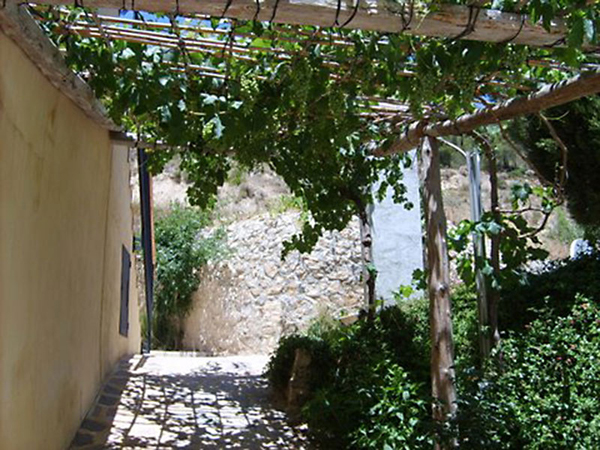
Do you like large shaded porches with lots of plants? Vine covered trellises help cool the earth around your home, block glare and add extended living space. They even help protect your walls by blocking blowing rain and snow… and they’re inexpensive and easy to build if you use local wood or salvaged materials. The pergola shown here uses rafters, posts and beams. Consider adding a view of the garden and surrounding area. And you might want to consider planting some edibles. How about some hanging grapes? One thing is for sure, the older I get the more I appreciate shady outdoor living areas versus being cooped up inside.
Source: Casasella.com

Yeah right..hahahaha
Good idea except, I’d probably have to build one far enough from the house so as to not bring in the chicken droppings. I’m not in favor of sitting out there in the rocking chair in my slippers and walking a trail back into my living room. It’s just not that appealing. If built far enough from the house, you could walk back in the grass and clean your shoes at the same time but, you’d have to forget the bedroom slippers. Now ay….”Get outta’ my yard”
Come on Carroll, it’s natural. You got to get back to nature. Ha ha.
Awesome! This does hit two birds with one stone. First, it makes a good covering for porches, making a cool hangout place when the indoors are too warm, or to sit down and take in some scenery. Second, it’s also some kind of protection for the home’s siding from the elements’ damages.
Any time you have the good fortune of an abundance of any fruit falling to the ground, it is an opportunity.
All you need to do is graze livestock of some kind underneath. Chickens, for example.
They’ll happily clean up the mess. Then they will fertilize the grapes, or whatever is growing on the trellis.
This technique is a very old one. My grandfather built his chicken coop underneath the shade of a huge Mulberry tree. Between the bugs the Mulberries, he hardly had to feed his chickens during the warm months. Got the eggs for free.
And… the yolks of his chickens’ eggs were very deep and dark, due to the Mulberry feeds. Extremely rich and tasty.
In fact, I would go so far as to say, design your chicken coop to incorporate a pergola for just this purpose.
I think Owen just admitted to being a shady character!
;)
Another aspect of Trellis and Pergolas is that they can be a speedy alternative to shade trees.
In most temperate climates, it is advisable to site a home in a spot that will be shaded by deciduous trees. They will shade the home in the summer months, but in the winter months will drop their leaves allowing the sun to warm the home.
Sometimes, on some properties, there simply are not sufficient mature strategically placed trees to accomplish this.
Yes, it is wise to plant such trees as soon as possible, but they can take years to reach sufficient size to have an appreciable effect.
Trellis and Pergolas can at least partially serve as a living shade system for a structure in the first year. While it may not be practical to try to shade an entire roof with a pergola, at least shading the South and West walls of a structure can have a big impact.
Plus, it gives a great spot for a rocking chair with and old guy to sit in and holler at the kids to “Get off my LAWN!”
Except… I don’t think Owen has much, if any, lawn. Unless you count the grass he lets grow on top of his earthbag dome. Yup, Owen really is a shady character!
Good point about how trellises and pergolas can provide shade in a hurry as you wait for your trees to grow. One option is to add poles or boards on top of the rafters to provide immediate shade. Maybe you could wait a year in some climates, but you’d want shade immediately in really hot climates like New Mexico and Arizona. I’ve even seen certain types of old dead cactus, reeds and salt cedar used on top for shade.
Here’s one low cost example: http://1.bp.blogspot.com/-ypAQgcwuYVc/TbNy4PwDpQI/AAAAAAAABO0/AaswLvkcrxI/s1600/san%2Bsaba%2Beaster%2B2011%2B002.JPG
I like the idea of grapes growing and shading an area. Unless, there’s reason not to use it. I’m thinking of grapes everywhere that’s fallen to the ground. The ones you can’t harvest fast enough. Am I being overly skeptic using grapes? And, is there a better choice for the north west U.S.
Try to find a gardening forum with folks from your area. They’ll be able to give you specific advice. Grapes may or not be the best choice, not sure. I saw this at an organic farm once in Oregon and fell in love with the idea. We bought some Concord grapes from them and they just reached up with some scissors and snipped off some bunches.